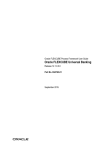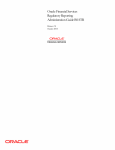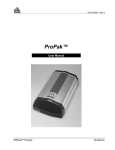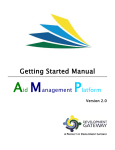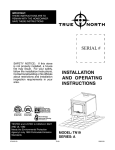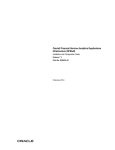Download Oracle Financial Services Operational Risk Installation Guide
Transcript
Oracle Financial Services Operational Risk Installation Guide Release 6.0 June 2014 Oracle Financial Services Operational Risk Installation Guide Release 6.0 June 2014 Document Control Number: 9112-6001002 Document Number: IG-14-OR-0002-6.0-01 Oracle Financial Services Software Limited Oracle Park, Off Western Express Highway, Goregaon (East) Mumbai, Maharashtra 400 063 India Document Number: IG-14-OR-0002-6.0-01 First Edition (June 2014) Copyright © 1996-2014, Oracle and/or its affiliates. All rights reserved. Printed in U.S.A. No part of this publication may be reproduced, stored in a retrieval system, or transmitted in any form or by any means, electronic, mechanical, photocopying, recording, or otherwise without the prior written permission. Trademarks Oracle is a registered trademark of Oracle Corporation and/or its affiliates. Other names may be trademarks of their respective owners. Oracle Financial Services Software Limited Oracle Park, Off Western Express Highway, Goregaon (East) Mumbai, Maharashtra 400 063 India Phone: +91 22 6718 3000 Fax:: +91 22 6718 3001 Internet: www..oracle.com/financialservices Contents List of Figures .................................................................................................................. 5 List of Tables .................................................................................................................... 7 About this Guide .............................................................................................................. 9 Who Should Use this Guide ................................................................................................................................................9 Scope of this Guide...............................................................................................................................................................9 How this Guide is Organized ..............................................................................................................................................9 Where to Find More Information ....................................................................................................................................10 Conventions Used in this Guide .......................................................................................................................................10 C HAPTER 1 About Oracle Financial Services Operational Risk ...................... 1 The Oracle Financial Services Operational Risk Components ......................................................................................2 Risk Control and Self Assessment...............................................................................................................................2 Incidents ..........................................................................................................................................................................2 Key Indicators ................................................................................................................................................................2 Issues and Actions .........................................................................................................................................................2 Scenario............................................................................................................................................................................3 BU Risk Profile...............................................................................................................................................................3 Compliance .....................................................................................................................................................................3 Dashboard.......................................................................................................................................................................3 Administrative Functions .....................................................................................................................................................4 Reference Data Maintenance........................................................................................................................................4 Financial Impact Scales .................................................................................................................................................4 Application Preference..................................................................................................................................................4 Preference........................................................................................................................................................................4 Delegation .......................................................................................................................................................................5 Universal Search .............................................................................................................................................................5 Access Rights ..................................................................................................................................................................5 Planning and Scoping ....................................................................................................................................................5 Questionnaire..................................................................................................................................................................5 C HAPTER 2 Preparing to Install .......................................................................... 7 Environment ..........................................................................................................................................................................7 Pre-requisites ..........................................................................................................................................................................8 Pre-Installation Activities ....................................................................................................................................................8 Pre-Installation Checklist......................................................................................................................................................9 Contents C HAPTER 3 Installation Activities..................................................................... 11 Installation Process..............................................................................................................................................................11 Copying the Required Files to Installation Directory.............................................................................................11 Creating Atomic Schema User and Tablespaces .....................................................................................................11 Populating the GRC_InstallConfig.xml File ............................................................................................................12 GENERAL Layer.................................................................................................................................................13 APPLICATION Layer .........................................................................................................................................14 DATABASE Layer...............................................................................................................................................17 WEB Layer .............................................................................................................................................................18 Installing Oracle Financial Services Operational Risk............................................................................................19 Installation Log Files ................................................................................................................................................19 C HAPTER 4 Post-Installation Activities............................................................ 21 Resource Reference Configuration ...................................................................................................................................21 Email Configuration............................................................................................................................................................21 Test Data...............................................................................................................................................................................22 Start / Stop Services ...........................................................................................................................................................22 Save Metadata.......................................................................................................................................................................22 C HAPTER 5 Uninstalling the Operational Risk Application............................ 23 Overview...............................................................................................................................................................................23 Prerequisites..........................................................................................................................................................................23 Uninstalling the Operational Risk Application ...............................................................................................................23 Note .......................................................................................................................................................................................23 C HAPTER 6 Deploying Operational Risk Dashboards Analytics ................... 25 Installing OBIEE Server ...................................................................................................................................................25 Installing OBIEE Windows Administration Client .......................................................................................................25 Disabling the Cache Feature in OBIEE Server ..............................................................................................................26 Deploying Operational Risk Report Analytics................................................................................................................27 Post Installation Steps.........................................................................................................................................................41 APPENDIX A Pre-installation Configuration ..................................................... 43 Creating Information Domain and Segment ..................................................................................................................43 Uploading Data Model .......................................................................................................................................................43 iv Oracle Financial Services OR 6.0 Installation Guide List of Figures Figure 1. OBIEE Windows Administration Screen to Disable the Cache ........................................................................26 Figure 2. OBIEE Windows Administration Client to Open Repository...........................................................................27 Figure 3. OBIEE Windows Administration Client to Select Repository from Windows Machine...............................28 Figure 4. OBIEE windows Administration Client to enter Repository Default Password.............................................29 Figure 5. OBIEE Windows Administration Client to Change the Password of Repository ..........................................30 Figure 6. OBIEE Windows Administration Client to Open Connection Pool Window ................................................31 Figure 7. OBIEE Windows Administration Client to modify Connection Pool variables .............................................32 Figure 8. OBIEE Windows Administration Client to modify Connection Pool-VAR_CONN_POOL variables....33 Figure 9. OBIEE Windows Administration Client to save Repository changes ..............................................................34 Figure 10. OBIEE Windows Administration Client to check global consistency ............................................................35 Figure 11. OBIEE Windows Administration Client with global consistency checking message ..................................36 Figure 12. OBIEE Enterprise Manager to deploy Repository ............................................................................................37 Figure 13. OBIEE Enterprise Lock and Edit Configuration Page .....................................................................................38 Figure 14. OBIEE Enterprise Activate Changes page .........................................................................................................39 Oracle Financial Services OR 6.0 Installation Guide 5 List of Figures 6 Oracle Financial Services OR 6.0 Installation Guide List of Tables Table 1. Table 2. Table 3. Table 4. Table 5. Table 6. Table 7. Table 8. Conventions Used in this Guide ..............................................................................................................................10 Environment Requirement Table...............................................................................................................................7 Front End Access .........................................................................................................................................................8 Pre Installation Checklist .............................................................................................................................................9 Layer - GENERAL ....................................................................................................................................................13 Layer - Application .....................................................................................................................................................15 Layer - DATABASE...................................................................................................................................................17 Interaction Groups in Layer - WEB ........................................................................................................................18 Oracle Financial Services OR 6.0 Installation Guide 7 List of Figures 8 Oracle Financial Services OR 6.0 Installation Guide About this Guide This guide provides comprehensive instructions for installing and configuring the Oracle Financial Services Operational Risk (herein referred to as OFSOR or OR). This chapter discusses the following topics: Who Should Use this Guide Scope of this Guide How this Guide is Organized Where to Find More Information Conventions Used in this Guide Who Should Use this Guide The Oracle Financial Services Operational Risk Installation Guide, Release is designed for use by Oracle Financial Services Operational Risk Installers and System Administrators. Their roles and responsibilities include the following: OFSOR System Administrator: This user installs, configures, maintains, and adjusts the system and is usually an employee of a specific Operational Risk client. The System Administrator maintains user accounts and maps roles to users. OFSOR Installer: This user installs, configures, and maintains OR application at the deployment site. Scope of this Guide This guide provides step-by-step instructions for installing the Oracle Financial Services Operational Risk on an existing Oracle Financial Services Analytical Applications Infrastructure (OFSAAI) platform hosted on a suitable environment. How this Guide is Organized The Oracle Financial Services Operational Risk Installation Guide, Release 6.0, includes the following topics: Chapter 1, About Oracle Financial Services Operational Risk, provides a brief overview of the application. Chapter 2, Preparing to Install, details the prerequisites, environment, and installation checklist that are necessary for installing the Oracle Financial Services Operational Risk. Chapter 3, Installation Activities, describes the step-by-step installation activities for installing Oracle Financial Services Operational Risk application. Chapter 4, Post-Installation Activities, details the steps that are to be performed after successful installation of Oracle Financial Services Operational Risk application. Chapter 6, Deploying Operational Risk Dashboards Analytics, explains how to deploy Operational Risk Report Analytics on Oracle Business Intelligence Enterprise Edition (OBIEE) Appendix A, Pre-installation Configuration, details the pre-installation activities. Oracle Financial Services OR 6.0 Installation Guide 9 Where to Find More Information About this Guide Where to Find More Information For more information on the Oracle Financial Services Operational Risk, refer to the following documents: Oracle Financial Services Operational Risk Release Notes: This guide details the latest updates on hardware and software requirements. Oracle Financial Services Operational Risk User Guide: This guide provides information about the general features across all the modules in the Oracle Financial Services Operational Risk application. To find additional information about how Oracle Financial Services solves real business problems, visit our website at www.oracle.com/financialservices. Conventions Used in this Guide Table 1 lists the conventions used in this guide. Table 1. Conventions Used in this Guide Convention Meaning Italics Names of books, chapters, and sections as references Emphasis Bold Object of an action (menu names, field names, options, button names) in a step-by-step procedure Commands typed at a prompt User input Monospace Directories and subdirectories File names and extensions Process names Code sample, including keywords and variables within text and as separate paragraphs, and user-defined program elements within text <Variable> 10 Substitute input value Oracle Financial Services OR 6.0 Installation Guide CHAPTER 1 About Oracle Financial Services Operational Risk Oracle Financial Services Operational Risk Solution (OFSOR) enables the creation of a comprehensive framework to manage enterprise governance, risk, and compliance across the organization. The solution is built on Oracle Financial Services Analytical Applications Infrastructure (OFSAAI), the industry's only integrated business infrastructure designed to serve both Enterprise Risk and Compliance requirements. OFSOR solution provides the ability to conduct RCSA, record losses, track KIs, maintain Insurance and Compliance libraries, and compute economic capital, thus providing all the elements required for addressing Basel II compliance. Oracle Financial Services Analytical Applications Infrastructure is a business intelligence application developed by Oracle Financial Services Software to meet the information needs of the various business segments such as, banking, insurance, and other financial service companies. It is a web-enabled application for anywhere access and has an n-tiered architecture that provides the required security, scalability, and availability. The OFSAAI technology tool-set (also referred to as the toolkit or platform) is qualified on various combinations of OS/RDBMS/MDBMS/Web Server thereby providing a range of options to the customers to deploy the application. This chapter discusses the following topics: The Oracle Financial Services Operational Risk Components Administrative Functions Oracle Financial Services OR 6.0 Installation Guide 1 The Oracle Financial Services Operational Risk Components Chapter 1—Introduction to Oracle Financial Services Operational Risk The Oracle Financial Services Operational Risk Components The Oracle Financial Services Operational Risk application contains the following functional components: Risk Control and Self Assessment Incidents Key Indicators Issues and Actions Scenario BU Risk Profile Compliance Dashboard Risk Control and Self Assessment This is a comprehensive solution to enable the organization to capture risks, controls, create assessment plans, assess risks, as well as assess the effectiveness of controls. It entails the involvement of line of business management and staff in the identification and assessment of various risks and related controls, facilitated by central operational risk management and other central control functions (internal audit, compliance, and so on) as also specialist departments such as HR, Building Maintenance, IT, and so on. Incidents This framework facilitates an institution to establish a consistent and comprehensive process for capturing all the elements of a loss. An individual operational risk event can lead to losses in multiple business lines, and losses arising from a single event can sometimes span to multiple event types. The Incident Management component covers losses from all organizational units and location (Key Business Dimensions) that could generate an operational risk. Key Indicators This allows the definition, capture, and assessment of Key Indicators (KI). KI provides an early warning system for management as they help in the identification of changes to a business unit's risk profile and initiate corrective measures to mitigate operational risk. KI could be either Key Risk Indicators or Key Control Indicators. Issues and Actions This offers the ability to plan and implement measures (referred to as actions) for specific problems (referred to as issues) such as operational losses, unacceptable risks, or control weaknesses. An issue describes a problem which has to be solved and an action is the effort taken to solve the issue. In order to do this, actions can be associated to the issue. Alternatively, no action is taken to solve an issue either because the risk is less than the risk mitigation cost, or because there are insurances covering the risk. If the issue is not accepted, one or more actions have to be defined for the issue. These actions are not necessarily executed by the owner of the issue. When all the actions are completed, the issue itself is complete and can be closed. 2 Oracle Financial Services OR 6.0 Installation Guide The Oracle Financial Services Operational Risk Components Chapter 1—Introduction to Oracle Financial Services Operational Risk Scenario This may be defined as an outline, description, or model of a sequence of unexpected or adverse events. Scenarios vary in detail according to the level of the organization at which they are researched and focused, but are generally made up of similar components. They are described using event types and may detail the causes and potential impacts of the event. Scenarios may also include a causal analysis, along with expected direct and indirect impacts, particularly those of reputational nature. BU Risk Profile Business Unit Risk Profile is a new component which provides an overview of the entire BU. All the risks, controls, processes, incidents, change initiatives, regulations, obligations, issues and actions, and information libraries for this BU with their latest assessments/ratings/status are displayed in this component. This component helps top management in getting a consolidated view of the entire BU. Change Management is a new component which provides an ability to the financial institutions for recording and monitoring all change initiatives that are implemented within the organization and tracking all the risks associated with those change initiatives along with their progress. Financial attestations can also be carried out as part of BU Risk Profile. This function provides for creation of various information libraries such as Products library, Financial Models library, Internal IT Systems library, and so on. These libraries can be used from various components such as RCSA, and so on Organizations have insurance policies to cover risks, and future losses arising out of such risks. The policy details can be captured in a central repository in the insurance policy library. Once the insurance policy is captured in the library it can be mapped to the specific business line and location to which it is applicable. Whenever there is a loss, insurance policies can be linked from incident management if recoveries are made from insurance. Compliance This function enables the organization to manage the regulations/policies and the obligations associated with them. This function assists the organization in managing assessment and attestations of processes, obligations, controls along with regulations. It also enables the organization to maintain a repository of documents related to regulations and policies and notify the relevant users on uploading updated documents to the repository. Dashboard The Oracle Financial Services Operational Risk solution is integrated with Oracle Business Intelligence Enterprise Edition (Oracle BI EE) which enables the user to access the dashboard reports for powerful and flexible analytic reporting. Oracle Financial Services OR 6.0 Installation Guide 3 Administrative Functions Chapter 1—Introduction to Oracle Financial Services Operational Risk Administrative Functions This section discusses the following topics: Reference Data Maintenance Financial Impact Scales Application Preference Preference Delegation Universal Search Access Rights Planning and Scoping Questionnaire Reference Data Maintenance The Oracle Financial Services Operational Risk Reference Data Maintenance function enables the organizational hierarchies and the assignment of entities like risk, control, incidents, key indicators, and issues to different business line and location. New nodes can be added and existing nodes can be modified for the hierarchies or drop-down values. For example, users can capture business line, location, causes, and so on. Existing nodes can be deactivated from the hierarchy. Risk, controls, key indicators, incident, and issue can be moved or copied from a business line and location to another business line and location or even deleted from the selected KBD. Financial Impact Scales Financial Impact Scales are required to define Business Unit Impacts for Risk Assessment, Lower and Upper Threshold for Incidents and Base Currency for general use. This Admin setting must be defined at the start of implementation so risk assessment and incident workflows can be handled smoothly. Application Preference Application Preferences allows you to manage workflows of each module of OFSOR and GCM and set the user interface language. The Workflow Management functions enable the maintenance of workflows to be used based on user preferences. Workflow Management enables modifying the existing workflow based on business line and location combination. This will enable the users to have a complex workflow or a simple workflow for each business line and location combination. Language Manager allows you to manage or modify the labels in the User Interface. This function allows you to capture the labels of the screen, panels, and fields in different languages. It also allows maintenance of the alert messages. Preference The Preferences feature allows you to set and manage the email notification configurations. 4 Oracle Financial Services OR 6.0 Installation Guide Administrative Functions Chapter 1—Introduction to Oracle Financial Services Operational Risk Delegation Delegation is a general administration function created in order to serve business continuity purpose, where a user's rights can be delegated or assigned to another user in absence of original user to perform and close all pending tasks. On delegation, the delegated user's rights will be over and above their original rights. All task items and notifications to Delegator will also get assigned to the Delegate. Universal Search The Universal Search feature allows you to perform a search across all records in the application Access Rights The Access Rights feature allows you to maintain user groups and the mapping of roles to user groups. It also allows you to map users to specific groups, providing role mapping for a Business Line and Location combination. Planning and Scoping Assessment plans can be created for risk assessment, control assessment, risk and control assessment, process attestation, and control attestation. This is a onetime set up and reduces the burden of creating similar/identical assessment plans for multiple risks/controls/risk and controls and attestation for process and control. Planning and scoping allows the user to set up assessment plans for a particular entity as a whole, bringing in uniformity in assessment cycle throughout the organization. It also helps in easier tracking of risk/control/RCSA type assessments and process/control attestations. The user sets the periodicity of the assessment in this component for the above mentioned entities (weekly, monthly, quarterly, yearly, semiannually, and custom). Questionnaire Questionnaire aids in assessment of risks, controls, regulations, and obligations. A questionnaire is a set of questions which can be linked during assessments. Questionnaires can be used to derive automatic ratings as well as they can be used as an input for assessments without the rating driven by them. Oracle Financial Services OR 6.0 Installation Guide 5 Administrative Functions Chapter 1—Introduction to Oracle Financial Services Operational Risk 6 Oracle Financial Services OR 6.0 Installation Guide CHAPTER 2 Preparing to Install This chapter provides information on pre-requisites, environment, hardware and software requirements, and installation checklist that are necessary for installing the Oracle Financial Services Operational Risk application. This chapter covers the following topics: Environment Pre-requisites Pre-Installation Activities Pre-Installation Checklist Note: Refer to the Oracle Financial Services Operational Risk Release Notes for the latest updates on the hardware or software requirements. Environment The Oracle Financial Services Operational Risk is installed using the hardware and software environment as described in Table 2. Table 2. Environment Requirement Table Operating System Hardware Oracle Enterprise Linux Server Release 5.8 (Carthage) - 64 bit Desktop machine with 4GB RAM for front-end access Oracle Financial Services OR 6.0 Installation Guide Software Oracle Database Enterprise Edition Release 11.2.0.2.0 - 64 bit with or without RAC Sun JDK Standard Edition 1.6.0_25 - 64 bit WebLogic 10.3.5.0 (64 bit) Websphere 7.0.0.17 (64 bit) Tomcat 7.0.19 (64 bit) Oracle Business Intelligence Enterprise Edition v 11.1.1.7.0 OFSAAI 7.3.2.6.0 7 Pre-requisites Chapter 2—Preparing to Install The following table explains the Front End Access: Table 3. Front End Access Front End Access Microsoft Internet Explorer 8 / 9 Microsoft Office 2003 / 2007 Client Machines – Windows XP SP3 / Windows 7 Screen resolution, 1024*768 and 1280*1024 Adobe Reader 8.0 Java plug-in - 1.6.0_21 Note: 1. Ensure that Java Plug-in is enabled in the browser settings. 2. Enable caching of static content (static files, images, CSS, etc) for browser client. 3. Ensure cookies are disabled. Note: Refer to Chapter 6 - Deploying Operational Risk Dashboards Analytics to configure Operational Risk Dashboards. Pre-requisites 1. Once the Oracle Financial Services Analytical Applications Infrastructure is installed, it must be configured with server details. For more information on configuring the Oracle Financial Services Analytical Applications Infrastructure platform, refer to the Oracle Financial Services Analytical Applications Infrastructure System Configuration and Administration User Guide. 2. Infrastructure version 7.3.2.6.0 should be installed, and the below one-off patch should be applied: Bug 18447412 - Hierarchy Drop-down Should Become Popup on Breaching Max. Nodes Specified Pre-Installation Activities This section explains the pre-installation activities to be performed by the System Administrator before starting the installation of Oracle Financial Services Operational Risk application. 1. Take a backup of the following before the application installation process starts. The backup should be kept until the application runs successfully. OFSAAI Configuration schema OFSAAI Installation directory OFSAAI FTPSHARE directory OFSAAI Atomic Schema 2. Create Table spaces and database user for OFSAAI Atomic Schema. Make the TNS entry for the atomic schema user in the TNSNAMES.ORA file in the system where OFSAAI database components are installed. For more information on creating atomic schema users and table spaces, refer section Creating Atomic Schema User and Tablespaces, on page 11. 8 Oracle Financial Services OR 6.0 Installation Guide Pre-Installation Checklist Chapter 2—Preparing to Install 3. Database parameters should be set as Processes = 2000 and Sessions = 3000. 4. Provide the following grant to the config schema user. grant select on sys.V_$TABLESPACE to <<Config Schema>>; Pre-Installation Checklist Table 4 lists the pre-installation checklist to be completed before starting the installation of Oracle Financial Services Operational Risk. Table 4. Pre Installation Checklist # Task Done (Y/N) Items 1-8 contains checklist on readiness with required information. 1 Ensure that the Oracle Database instance is up and running. 2 Ensure that the FTP share path as configured in OFSAAI platform is available. 3 Ensure that the IP address or host name is available. 4 Ensure that the servlet port is available. 5 Ensure that the OFSAAI configuration schema user ID and password is available. 6 Ensure that the Oracle SID is available. 7 Ensure to have 'Recursive Write' permission on 'ftpshare' paths of APP, DB, and WEB layers. 8 Ensure that the 9 digit customer identification number is available. Items 9-12 contains completeness check on pre-installation activities. 9 Ensure to take a backup of the following before the application installation process starts: Configuration Schema OFSAAI Installation Directory OFSAAI FTPSHARE directory OFSAAI Atomic Schema Refer to section Pre-Installation Activities , on page 8 (Step 1), for more information. 10 Ensure that the Table space and Database user are created. Refer to section Pre-Installation Activities , on page 8 (Step 2), for more information. 11 Verify that tnsnames.ora file which is updated with the OFSAAI atomic schema has been created. Refer to section Pre-Installation Activities , on page 8 (Step 2), for more information. 12 Ensure that OFSAAI servers are running during APP layer Installation. 13 Ensure that Application Server and Web Application Server have the FQDN signature of each other in the known_hosts file located under <USER_HOME>/.ssh folder. Oracle Financial Services OR 6.0 Installation Guide 9 Pre-Installation Checklist Chapter 2—Preparing to Install 10 Oracle Financial Services OR 6.0 Installation Guide CHAPTER 3 Installation Activities The Oracle Financial Services Operational Risk comprises of components that are installed in the OFSAAI Web, Application, and Database layers. If OFSAAI has been installed in single-tier architecture, the OFSOR installer is required to be invoked only once on the machine that hosts all the OFSAAI tiers. If OFSAAI has been installed in multi-tier architecture, the OFSOR installer must be invoked on each machine that hosts an OFSAAI Platform tier. Installation Process This section covers following topics: Copying the Required Files to Installation Directory Creating Atomic Schema User and Tablespaces Populating the GRC_InstallConfig.xml File Installing Oracle Financial Services Operational Risk Following are the step-by-step instructions for installing OFSOR on a single-tier mode: Copying the Required Files to Installation Directory 1. Login with the Unix user(s) on the server(s) which hosts OFSAAI APP, DB, and WEB layers, and copy the following files from the eDelivery into any directory: a. Setup.sh b. Setup.bin c. GRC_InstallConfig.xml d. validateXMLInputs.jar e. log4j.xml f. prerequisites.sql g. Data_Model folder containing the datamodel file. Note: a. If OFSAAI APP Layer, DB Layer, and WEB Layer are installed on different servers/users, files must be copied under all servers/users. b. Copy Setup.sh, log4j.xml, Data_Model folder, prerequisites.sql, and GRC_InstallConfig.xml in text mode. c. Copy Setup.bin and validateXMLInputs.jar in binary mode to avoid control character. d. Grant 750 permission to all the files. Creating Atomic Schema User and Tablespaces To create atomic schema user and table spaces, follow these steps: Oracle Financial Services OR 6.0 Installation Guide 11 Installation Process Chapter 3—Installation Activities 1. Login to database hosting OFSAAI Configuration Schema, with user having DBA privileges, and execute prerequisites.sql. 2. Provide the following parameters you are prompted to input: Enter a path where spool file will be created. Enter a name for OR Data Table space. Enter absolute path (with file name) of data file for Data Table space. Enter a name for OR Index Table space. Enter absolute path (with file name) of data file for Index Table space. Enter a name for OR Atomic Schema User. Enter a password for OR Atomic Schema User. Note: If the atomic schema and table spaces (data and index table spaces) were created previously ensure that you have provided necessary grants/permissions as mentioned in prerequisites.sql. Also, make sure that the data table space is the default table space for the atomic user and you have an index table space present: Populating the GRC_InstallConfig.xml File This file contains the following four layers: GENERAL Layer APPLICATION Layer DATABASE Layer WEB Layer contains placeholders, in the format ##<PLACEHOLDER Name>##, wherever user input is required. Replace these placeholders with the corresponding values as mentioned below. GRC_InstallConfig.xml 12 Oracle Financial Services OR 6.0 Installation Guide Installation Process Chapter 3—Installation Activities GENERAL Layer The Layer GENERAL (<Layer name="GENERAL">) contains the following placeholders to provide the parameter values specific to Users’ system. The variables under the GENERAL tag needs to be configured mandatorily for all the types of installations. All the placeholders for this layer are tabulated below: All the nodes for this layer are listed in Table 5. Table 5. Layer - GENERAL Placeholders Description ##CUSTID## This variable is used to store the Customer ID. Replace this placeholder with Customer Code used during OFSAAI Installation. Example: <VariableGroup name="OFSAA_INFRASTRUCTURE_CUSTOMER_CODE"> <Variable name="CUSTID">EDELIVERY</Variable> </VariableGroup>> ##PRE_INSTALL## This variable is used to identify whether installer will perform the following Pre-Installation activities. Infodom and Segment Creation for OFSOR atomic schema. Data Model Upload for OFSOR atomic schema. Replace this placeholder with either of below values: Allowable values are 0 and 1 1 - If user wants one or more of the above Pre-Installation steps to be performed by installer. 0 - If the user has performed all the above steps through OFSAAI front-end. For more information, refer to Chapter Appendix A, “ section under References”. Example: <VariableGroup name="PRE_INSTALLATION"> <Variable name="PRE_INSTALL">1</Variable> </VariableGroup> Note: Oracle recommends Installer to perform all these steps. In case OFSOR installation has been performed second time after successful Un-installation then will keep this parameter as 0 since it is a onetime activity. Oracle Financial Services OR 6.0 Installation Guide 13 Installation Process Chapter 3—Installation Activities Table 5. Layer - GENERAL (Continued) Placeholders Description ##INFODOM_1## ##INFODOM_2## ##INFODOM_3## These variables are used to specify the OFSOR Information Domain name. Replace all the three placeholders with the same Infodom name in either of the below cases: If already created from OFSAAI front end To be created by Installer. Example: <Variable name="INFODOM_NAME">ORINFODOM</Variable>> Note: Make sure to follow below convention while giving a new Information Domain Code: Ensure that the Information Domain name specified is of minimum 6 characters long. ##SEGMENT_1## ##SEGMENT_2## ##SEGMENT_3## Ensure that the Information Domain name does not contain any special characters or extra spaces. Ensure that the maximum length of Information Domain name should be less than or equal to 20 characters. Ensure that the Information Domain name is in Uppercase. These variables are used to specify the OFSOROR Segment Code. Replace all the three placeholders with the same Segment Code in either of the below cases. If already created from OFSAAI front end To be created by Installer Example: <Variable name=”SEGMENT_CODE">ORSEGMENT</Variable> Note: Make sure to follow below convention while giving a new Segment Code: Enter a unique segment code. ##FTPSHARE_PATH## Ensure that there are no special characters and extra spaces in the code entered. Ensure that maximum length of Segment Code should less than or equal to of 10 characters. Ensure that the Information Domain name is in Uppercase. This variable is used to identify the common share area path. Replace this placeholder with the same path as configured during OFSAAI Installation. Example: <VariableGroup name="LOCAL_FTPSHARE_PATH"> <Variable name="FTPSHARE_PATH">/home/ftpshare</Variable> </VariableGroup> 14 Oracle Financial Services OR 6.0 Installation Guide Installation Process Chapter 3—Installation Activities APPLICATION Layer The Layer APPLICATION (<Layer name="APPLICATION">) consist of the following placeholders, which must be replaced for installation of Application Layer as one of its component. Table 6. Layer - Application Placeholders Description ##APP_LAYER## This flag is used to Identify if OFSOR Application Layer component are to be installed on this machine. Allowable values for this placeholder are 0 and 1. Replace this placeholder with: 1 – If APPLICATION Layer component is to be installed 0 – If APPLICATION Layer component is not to be installed Replace the place holder with 1 in case of OFSAAI was installed in Single – Tier mode. Note: In case of OFSAAI was installed in Multi –Tier mode, this value needs to be set according to OFSAAI Application layer installed on this machine: Replace the placeholder with 1 for the machine hosting OSFAAI application layer. ##DB_USER_1## Replace the placeholder with 0 for the machine NOT hosting OSFAAI application layer. This variable is used to identify the OFSOR Atomic Schema. Replace the placeholder with OFSOR Atomic Schema Name. Example: <VariableGroup name=" OR_ATOMIC_USER"> <Variable name="ATOMIC_SCHEMA_USER_NAME">ORATOMIC</V ariable> </VariableGroup> Note: This value should be same as entered against OFSOR Atomic User name while running prerequisites.sql. ##APP_LOG_PATH## This variable is used to identify Application Layer Log path to store logs for all front-end and back-end components that will be created by OFSAAI in Application Layer. Replace this placeholder with an absolute path. Example: <Variable name="APP_LAYER_LOG_PATH">/home/ftpshare/ APP_logs</Variable> ##DB_LOG_PATH## This variable is used to identify Database Layer Log path to store logs for all front-end and back-end components that will be created by OFSAAI in Database Layer. Example: <Variable name="DB_LAYER_LOG_PATH">/home/ftpshare/DB_logs</V ariable> ##INFODOM_FLAG_1## This variable is used to identify the OFSOR Information Domain to be created by installer. Allowable values for this placeholder are 0 and 1. Replace this placeholder with 1 – If you want the installer to create the Infodom for OFSOR. 0 – If the Infodom was previously created. Oracle Financial Services OR 6.0 Installation Guide 15 Installation Process Chapter 3—Installation Activities Placeholders Description ##INFODOM_DESC_1## This variable is used to identify the OFSOR Information Domain Description. This value is required only if ## INFODOM_FLAG_1## and ##PRE_INSTALL## has been replaced by 1. Replace this placeholder with a description for OFSOR Information Domain by following below rules: Ensure the description field is not empty. Ensure that the description field has not exceeded 100 characters. Example: <Variable name="INFODOM_DESCRIPTION">Operational Rrisk Infodom</Variable> ##DB_NAME_1## This variable is used to identify the Database Name for OFSOR Information Domain. This value is required only if ## INFODOM_FLAG_1## and ##PRE_INSTALL## has been replaced by 1. Replace this placeholder with a name for the OFSOR Database by following below conventions: Ensure that there are no special characters and extra spaces in the name. Ensure the length of database Name has not exceeded 20 characters. Example: <Variable name="DATABASE_NAME">OFSORDB </Variable> Note: A TNS entry should be made in tnsnames.ora file with tnsname same as that of the value provided for OFSOR Database Name. ##MODEL_UPLOAD_FLAG_1 ## This variable is used to identify whether Data Model Upload for OFSOR is to be done through Installer. Allowable values for this placeholder are 0 and 1. Replace this placeholder with: 1 – If Data Model Upload for OFSOR is to be done through Installer. ##DM_TYPE_1## 0 – If Data Model Upload for OFSOR is already completed. This variable is used to identify type of Data Model Upload for OFSOR that is to be done through Installer. This value is required only if ##MODEL_UPLOAD_FLAG_1## and ##PRE_INSTALL## has been replaced by 1. Replace this placeholder with the type of DataModel upload to be performed. Allowable value is 0. 0=SLICED Model Upload Example: <Variable name="DATAMODEL_TYPE">0</Variable> Note: For first time Data Model upload in an Infodom, by default the type of Data Model upload chosen is NEW Model Upload. For subsequent Model Uploads on same Infodom, value of this variable is used for Data Model Upload Type. 16 Oracle Financial Services OR 6.0 Installation Guide Installation Process Chapter 3—Installation Activities Placeholders Description ##LOGICAL_UPLOAD_1## This variable is used to identify if Data Model Upload for OFSOR is to be Logical or not. This value is required only if ##MODEL_UPLOAD_FLAG_1## and ##PRE_INSTALL## has been replaced by 1. Replace this placeholder with the type of DataModel upload to be performed. Allowable value is 0. Example: <Variable name=" LOGICAL_UPLOAD">0</Variable> ##DM_FILE_PATH_1## This variable is used to identify Data Model file path used for OFSOR data Model Upload. This value is required only if ##MODEL_UPLOAD_FLAG_1## and ##PRE_INSTALL## has been replaced by 1. Replace this placeholder with the absolute path of DataModel file. Example: <Variable name="DATAMODEL_FILE_PATH">/home/OFSORkit/Data_ Model/ DataModel_OR_20.xml </Variable> DATABASE Layer The Layer DATABASE (<Layer name="DATABASE">) contains the following placeholders, which must be configured for installation of Database Layer as one of its component. Table 7. Layer - DATABASE Placeholders Description ##DB_LAYER## This flag is used to Identify if OFSOR Database Layer component are to be installed on this machine. Allowable values for this placeholder are 0 and 1. Replace this placeholder with: 1 – If DATABASE Layer component is to be installed 0 – If DATABASE Layer component is not to be installed Replace the place holder with 1 in case if OFSAAI was installed in Single – Tier mode. Note: In case OFSAAI was installed as Multi –Tier mode, this value needs to be set according to OFSAAI Database layer installed on this machine: Replace the placeholder with 1 for the machine hosting OSFAAI database layer. Replace the placeholder with 0 for the machine NOT hosting OSFAAI database layer. Oracle Financial Services OR 6.0 Installation Guide 17 Installation Process Chapter 3—Installation Activities Table 7. Layer - DATABASE Placeholders Description ##INDEX_TABLESPACE_1## Replace this placeholder with OFSOR INDEX Table space Name. Example: <Variable name=”INDEX_TABLE_SPACE”>OR_INDEXES_TBS</Variabl e> Note: This value should be same as the value provided for the Index Table space name while running prerequisites.sql. WEB Layer The Layer WEB (<Layer name="WEB">) contains following placeholders which must be configured for installations of the WEB layer as one of its component. Table 8. Interaction Groups in Layer - WEB Interaction Group Name Details of the Values to be Assigned to the Interaction Group ##WEB_LAYER## This flag is used to Identify if OFSOR Web Layer component are to be installed on this machine. Allowable values for this placeholder are 0 and 1. Replace this placeholder with: 1 – if WEB Layer component is to be installed 0 – if WEB Layer component is not to be installed Replace the place holder with 1 in case of OFSAAI was installed as Single – Tier mode.. Note: In case of OFSAAI was installed as Multi –Tier mode, this value needs to be set according to OFSAAI WEB layer installed on this machine. ##OBIEE## Replace the placeholder with 1 for the machine hosting OSFAAI web layer. Replace the placeholder with 0 for the machine NOT hosting OSFAAI web layer. This variable is used to identify whether Oracle Business Intelligence Enterprise Edition (OBIEE) needs to be integrated in the setup. Allowable values for this placeholder are 0 and 1. Replace this placeholder with: 0 – if OBIEE reports related files are not be installed 1 – if OBIEE reports related files are to be installed Example: <Variable name="OBIEE_REPORTS">1</Variable> 18 Oracle Financial Services OR 6.0 Installation Guide Installation Process Chapter 3—Installation Activities Installing Oracle Financial Services Operational Risk To install Oracle Financial Services Operational Risk, follow these steps: 1. Navigate to Home directory of Unix user, under which OFSAAI is installed and execute the .profile file using following command: . ./.profile 2. Navigate to the directory where OFSOR installer has been copied and provide execute permission for Setup.sh. 3. Execute the Setup.sh file using following command: ./Setup.sh SILENT Note: Do not execute Setup.sh with SILENT option in the nohup mode. In case of Multi-tier architecture, that is, where OFSAAI APPLICATION, DATABASE, and WEB Layer are installed on more than one server, the following order must be followed for installation: APPLICATION Layer DATABASE Layer WEB Layer The SILENT mode of installation does not require any simulator. The user will be prompted to input following users and passwords through console: Enter OR Atomic Schema Password / Re-enter OR Atomic Schema Password: Enter the password corresponding to the user entered against ##DB_USER_1##. If web layer is installed separately, then user will be prompted to input following users and passwords through console: Enter OR Config Schema Password / Re-enter OR Config Schema Password. Installation Log Files On completion of installation check the installation logs. Following is a list of logs created by installer: OR_LOG.log: This log is created in the directory where OFSOR installer has been copied. SolutionSetup_InstallLog.log: This log is created in FIC_HOME area of the machine where Installer was triggered. SolutionsLOG.log - This log is created in FIC_HOME area. If the logs contain any Fatal, Non-Fatal errors then bring them to the notice of Oracle Support. DO NOT proceed with the installation until all the concerns have been adequately addressed. Oracle Financial Services OR 6.0 Installation Guide 19 Installation Process Chapter 3—Installation Activities 20 Oracle Financial Services OR 6.0 Installation Guide CHAPTER 4 Post-Installation Activities This chapter describes the post-installation activities. This section covers following topics: Resource Reference Configuration Email Configuration Test Data Start / Stop Services Save Metadata Resource Reference Configuration Once the installation of OFSOR is completed, you must the Configure Resource Reference for the Infodom on which the OR is installed. Subsequently, redeploy the EAR/WAR file. For more information on Configuring Resource Reference and deploying EAR/WAR files, refer Oracle Financial Services Analytical Applications Infrastructure Installation Guide. Email Configuration Perform the following steps to configure the email utility. The web application server should have access to the SMTP server at the designated port. Update the following entries in the configuration table in config schema. Examples for available entries are the following: MAILUTILITY_PDFHEADER - ‘Oracle Financial Services Operational Risk’ MAILUTILITY_PDFPATH - This should be the full path of the profile report, that is generated in the .PDF format. The path is "##WebServer_DEPLOYEDPATH##/##OFSAAI##/WEB-INF/TempReports" MAILUTILITY_SLEEPINTERVAL - 40000 (in Micro Seconds) MAILUTILITY_STATUS - 'Yes' REV_MAIL_FROM - [email protected] REV_SMTP_HOST - 'internal-mail-router.oracle.com' REV_SMTP_PORT – 25 Update the following entries in dim_ror_configuration table in atomic schema: APP_URL - <OFSOR application URL> Oracle Financial Services OR 6.0 Installation Guide 21 Test Data Chapter 4—Post Installation Activities Test Data You can use the available test/sample data if you have implemented the Operation Risk as a stand alone application. In case of integrated environments, where Operational Risk is installed along with other applications, you should not use the test/sample data. Note: The Test_data.sql file can be found in $FIC_DB_HOME/Test_Data folder of DB layer. Start / Stop Services Once the installation of OFSOR has been completed successfully and the post-installation steps are completed, the servers must be restarted. For more information, refer to the Start/Stop Infrastructure Services section of Oracle Financial Services Analytical Applications Infrastructure Installation Guide. The Oracle Financial Services Operational Risk application is now ready for use. Save Metadata Login to the Application with OR Admin user and Resave all Hierarchies. Note: For more information, refer to OFSAAI 7.3 User Manual - Administration > Save Metadata section. 22 Oracle Financial Services OR 6.0 Installation Guide CHAPTER 5 Uninstalling the Operational Risk Application This chapter explains how to uninstall the the Operational Risk application. This section includes the following topics: Overview Prerequisites Uninstalling the Operational Risk Application Note Overview The Operational Risk Uninstaller removes all the seeded data inserted as part of the installation. Once the uninstallation is complete, you can install the Operational Risk application again on the same environment. Prerequisites Before you attempt to uninstall the application, ensure that you have performed the below tasks: Ensure that are no open connections to the Configuration Schema and Atomic Schema. Also make sure all Infrastructure servers are shutdown. Ensure to take a backup of the Configuration Schema, Atomic Schema, Installation Directory, and FTP Share folder. Uninstalling the Operational Risk Application To uninstall the Operational Risk application, follow these steps: 1. Run the .profile. 2. Navigate to $FIC_HOME/Uninstall_OR/ directory and grant execute permission to Uninstall_App.sh file. 3. Execute Uninstall_App.sh and follow the on-screen instructions. Note The following are the few items to be noted while performing the uninstallation: Uninstallation will not remove the Infrastructure application from the Web Application Server. Uninstallation will not remove the Form XMLs as they will get replaced during the subsequent installation. Model upload that occurred during the OR installation will not be dropped. Only the objects created by the OR installer such as Functions, Procedure, Synonyms and so on will be removed. Oracle Financial Services OR 6.0 Installation Guide 23 Note Chapter 5—Deploying Operational Risk Dashboards Analytics 24 Oracle Financial Services OR 6.0 Installation Guide CHAPTER 6 Deploying Operational Risk Dashboards Analytics This chapter explains how to deploy Operational Risk Report Analytics on Oracle Business Intelligence Enterprise Edition (OBIEE). This chapter includes the following sections: Installing OBIEE Server Installing OBIEE Windows Administration Client Disabling the Cache Feature in OBIEE Server Deploying Operational Risk Report Analytics Post Installation Steps Installing OBIEE Server To install Oracle Business Intelligence Enterprise Edition (OBIEE) server, refer to Oracle Fusion Middleware Installation Guide for Oracle Business Intelligence11g Release 1 (11.1.1). After installing Oracle Business Intelligence Enterprise Edition (OBIEE) server, get the Enterprise Manager URL, username, password, and OBIEE installed directory from the System Administrator. Note: Once the OBIEE server is installed, it should be upgraded to the version as mentioned in the Environment section. Installing OBIEE Windows Administration Client To install OBIEE repository administration client for Windows machine, refer to Oracle® Fusion Middleware Installation Guide for Oracle Business Intelligence11g Release 1 (11.1.1). Oracle Financial Services OR 6.0 Installation Guide 25 Disabling the Cache Feature in OBIEE Server Chapter 6—Deploying Operational Risk Dashboards Analytics Disabling the Cache Feature in OBIEE Server Login to Enterprise Manager, and perform the following steps: 1. Click Business Intelligence folder from left hand side menu and select coreapplicaiton (Figure 1). Figure 1. OBIEE Windows Administration Screen to Disable the Cache 2. Click on Capacity Management tab. Select Performance tab. 3. Click Lock and Edit Configuration tab. 4. Uncheck the Cache Enabled option to disable the cache. 26 Oracle Financial Services OR 6.0 Installation Guide Deploying Operational Risk Report Analytics Chapter 6—Deploying Operational Risk Dashboards Analytics Deploying Operational Risk Report Analytics To deploy Analytic Reports, follow these steps: 1. Stop Oracle Process Manager and Notification Server (OPMN) services by executing the following command: <OBIEE Installed Directory>/instances/instance1/bin ./opmnctl stopall 2. Copy OR_6.rpd from $FIC_HOME/OBIEE/Repository of Web layer to windows machine where the OBIEE windows administration client is installed. 3. To change the default password for the repository, follow these steps: a. Open the repository using OBIEE Windows administration client. Figure 2. OBIEE Windows Administration Client to Open Repository Oracle Financial Services OR 6.0 Installation Guide 27 Deploying Operational Risk Report Analytics Chapter 6—Deploying Operational Risk Dashboards Analytics Figure 3. OBIEE Windows Administration Client to Select Repository from Windows Machine 28 Oracle Financial Services OR 6.0 Installation Guide Deploying Operational Risk Report Analytics Chapter 6—Deploying Operational Risk Dashboards Analytics b. Enter default repository password as password123. Figure 4. OBIEE windows Administration Client to enter Repository Default Password Oracle Financial Services OR 6.0 Installation Guide 29 Deploying Operational Risk Report Analytics Chapter 6—Deploying Operational Risk Dashboards Analytics c. Click File menu, select Change Password. Figure 5. OBIEE Windows Administration Client to Change the Password of Repository d. Enter the new password. Click OK. 30 Oracle Financial Services OR 6.0 Installation Guide Deploying Operational Risk Report Analytics Chapter 6—Deploying Operational Risk Dashboards Analytics 4. To configure connection pool of repository, follow these steps: a. In the physical section, expand OR folder. Figure 6. OBIEE Windows Administration Client to Open Connection Pool Window b. Double-click Authorization Connection Pool to open the Connection Pool Properties window. c. Enter the following in Data Source Name text box of Connection Pool Properties window after modifying <Database Server Host Name> and <Database Name> (DESCRIPTION=(ADDRESS=(PROTOCOL=TCP)(HOST=<Database Server Host Name>)(PORT=1521))(CONNECT_DATA=(SERVER=DEDICATED)(SERVICE_NAME=<Database Name>))) d. Enter atomic schema user in User name text box. e. Enter atomic schema user password in Password text box. f. Click OK. Oracle Financial Services OR 6.0 Installation Guide 31 Deploying Operational Risk Report Analytics Chapter 6—Deploying Operational Risk Dashboards Analytics Figure 7. OBIEE Windows Administration Client to modify Connection Pool variables g. Double-click OR123 to open the Connection Pool window (Figure 8). h. Enter the following in Data Source Name text box of Connection Pool-VAR_CONN_POOL properties window after modifying <Database Server Host Name> and <Database Name> (DESCRIPTION=(ADDRESS=(PROTOCOL=TCP)(HOST=<Database Server Host Name>)(PORT=1521))(CONNECT_DATA=(SERVER=DEDICATED)(SERVICE_NAME=<Database Name>))) i. Enter atomic schema user in User name text box. j. Enter atomic schema password in Password text box. k. Click OK. 32 Oracle Financial Services OR 6.0 Installation Guide Deploying Operational Risk Report Analytics Chapter 6—Deploying Operational Risk Dashboards Analytics Figure 8. OBIEE Windows Administration Client to modify Connection Pool-VAR_CONN_POOL variables Oracle Financial Services OR 6.0 Installation Guide 33 Deploying Operational Risk Report Analytics Chapter 6—Deploying Operational Risk Dashboards Analytics 5. Click File menu and then click Save. Figure 9. OBIEE Windows Administration Client to save Repository changes 34 Oracle Financial Services OR 6.0 Installation Guide Deploying Operational Risk Report Analytics Chapter 6—Deploying Operational Risk Dashboards Analytics 6. Click Yes on the pop-up message Do you want to check global consistency? Figure 10. OBIEE Windows Administration Client to check global consistency Oracle Financial Services OR 6.0 Installation Guide 35 Deploying Operational Risk Report Analytics Chapter 6—Deploying Operational Risk Dashboards Analytics 7. Click OK, on the pop-up message Consistency check didn’t find any errors, warning or best practices violations. Note: Warnings on consistency check can be ignored. Figure 11. OBIEE Windows Administration Client with global consistency checking message 8. Copy OR_6.zip folder from <FIC_HOME>/OBIEE of Web layer and place under <OBIEE Installed Directory>/instances/instance1/bifoundation/OracleBIPresentationServicesComponent/core application_obips1/catalog 9. Unzip the OR_6.zip folder. 10. Login to Enterprise Manager. Click Business Intelligence folder at left hand side. Select coreapplication and then click on Deployment tab. 11. Click Repository tab. 36 Oracle Financial Services OR 6.0 Installation Guide Deploying Operational Risk Report Analytics Chapter 6—Deploying Operational Risk Dashboards Analytics Figure 12. OBIEE Enterprise Manager to deploy Repository 12. Click Lock and Edit Configuration. The Lock and Edit Configuration Confirmation window displays. Oracle Financial Services OR 6.0 Installation Guide 37 Deploying Operational Risk Report Analytics Chapter 6—Deploying Operational Risk Dashboards Analytics Figure 13. OBIEE Enterprise Lock and Edit Configuration Page 13. Click Close. 14. In Upload BI Server Repository section, browse the 0R_6.rpd file from Windows machine. 15. Enter the new repository password in the text boxes repository password and confirm password. 16. In BI Presentation Catalog section, provide the Catalog Location as <OBIEE Installed Directory>/instances/instance1/bifoundation/ OracleBIPresentationServicesComponent/coreapplication_obips1/ catalog/OR_6 17. Click Apply. 18. Click Activate Changes. An Activate Changes Confirmation window displays. 38 Oracle Financial Services OR 6.0 Installation Guide Deploying Operational Risk Report Analytics Chapter 6—Deploying Operational Risk Dashboards Analytics Figure 14. OBIEE Enterprise Activate Changes page 19. Click Close. 20. Modify <OBIEE Installer Directory> /instances/instance1/config/OracleBIPresentationServicesComponent/coreapplication_obip s1/instanceconfig.xml as shown in the following From <Security> <!--This Configuration setting is managed by Oracle Enterprise Manager Fusion Middleware Control--> <ClientSessionExpireMinutes>210</ClientSessionExpireMinutes> </Security> To <Security> <!--This Configuration setting is managed by Oracle Enterprise Manager Fusion Middleware Control--> <ClientSessionExpireMinutes>210</ClientSessionExpireMinutes> <InIFrameRenderingMode>allow</InIFrameRenderingMode> </Security> 21. Modify the <OBIEE Installed Directory>/OracleBI1/bifoundation/web/app/WEB-INF/web.xml Oracle Financial Services OR 6.0 Installation Guide 39 Deploying Operational Risk Report Analytics Chapter 6—Deploying Operational Risk Dashboards Analytics From <servlet-mapping> <servlet-name>RelatedContent</servlet-name> <url-pattern>/RelatedContent</url-pattern> </servlet-mapping> <login-config> <auth-method>CLIENT-CERT</auth-method> </login-config> To <servlet-mapping> <servlet-name>RelatedContent</servlet-name> <url-pattern>/RelatedContent</url-pattern> </servlet-mapping> <context-param> param-name> <param-name>oracle.adf.view.rich.security.FRAME_BUSTING</ <param-value>never</param-value> </context-param> <login-config> <auth-method>CLIENT-CERT</auth-method> </login-config> Re-start Weblogic 22. Start Oracle Process Manager and Notification Server (OPMN) services by executing the following command: ./opmnctl startall. from <OBIEE Installed Directory>/instances/instance1/bin directory. 40 Oracle Financial Services OR 6.0 Installation Guide Post Installation Steps Chapter 6—Deploying Operational Risk Dashboards Analytics Post Installation Steps In the OFSAAI Application config schema, the following entries are required: CONFIGURATION Table Name Parameter Name Value Configuration OBI_URL_<<INFODOM>> http://<ip address or hostname>:<port>/analytics/saw.dll for example: OBI_URL_ORINFO Configuration <<INFODOM_SEGMENT>>_OBI_URL http://<ip address or hostname>:<port> for example: ORINFO_ORSEG_OBI_URL Oracle Financial Services OR 6.0 Installation Guide 41 Post Installation Steps Chapter 6—Deploying Operational Risk Dashboards Analytics 42 Oracle Financial Services OR 6.0 Installation Guide APPENDIX A Pre-installation Configuration This appendix describes the pre-installation steps. It includes the following topics: Creating Information Domain and Segment Uploading Data Model Creating Information Domain and Segment Create information domain and segment to proceed the installation of solution. Refer to OFSAAI System Configuration & Administration User Manual for manually creating Information Domain and Segment. Uploading Data Model Data Model should be uploaded to the Atomic Schema created as a part of Pre-Installation Activity. The Oracle Financial Services Operational Risk Data Model is available in Data_Model folder. For more information on Data Model upload, refer section OFSAAI Unified Metadata Manager in OFSAAI User Manual. Oracle Financial Services OR 6.0 Installation Guide 43 Uploading Data Model Appendix A—Pre-installation Configuration 44 Oracle Financial Services OR 6.0 Installation Guide




























































